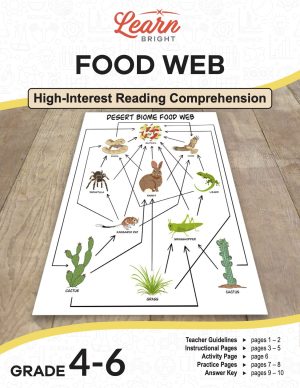Description
What our Religions of the World lesson plan includes
Lesson Objectives and Overview: Religions of the World teaches students all about the major religions, their origins, and how they’ve spread around the world. This lesson is perfect for complementing your existing world history curriculum. This lesson is for students in 5th grade and 6th grade.
Classroom Procedure
Every lesson plan provides you with a classroom procedure page that outlines a step-by-step guide to follow. You do not have to follow the guide exactly. The guide helps you organize the lesson and details when to hand out worksheets. It also lists information in the orange box that you might find useful. You will find the lesson objectives, state standards, and number of class sessions the lesson should take to complete in this area. In addition, it describes the supplies you will need as well as what and how you need to prepare beforehand. The only supplies you need for this lesson are the handouts.
Options for Lesson
Included with this lesson is an “Options for Lesson” section that lists a number of suggestions for activities to add to the lesson or substitutions for the ones already in the lesson. One optional addition to the lesson is to assign pairs of students a religion to research and create a poster about. You can ask your students to identify and research other, smaller religious denominations as well. For an additional activity, you could have students research and present some of the customs or rituals from one of the religions from the lesson.
Another idea is to invite religious leaders from local houses of worship to speak to your class. To add to the lesson, you could host a “Religions of the World Day” where you celebrate special holy days, rituals, customs, and more throughout the day. Finally, you can assign each student a religion to research and then create a matching poster with information, images, and more.
Teacher Notes
The teacher notes page includes a paragraph with additional guidelines and things to think about as you begin to plan your lesson. This page also includes lines that you can use to add your own notes as you’re preparing for this lesson.
RELIGIONS OF THE WORLD LESSON PLAN CONTENT PAGES
Religion
The Religions of the World lesson plan includes four content pages. Religion is one topic that can sometimes lead to an argument, like politics. Adults can have very different religious and political beliefs from each other, and this can lead to controversy. In politics, we have elections, political parties, voting, and more. You can have many different political views.
This is the same with religion. We have many different beliefs related to religion. We define religion as a set of beliefs related to the cause, nature, and purpose of the universe, including how the universe began. The practice of religion often includes rituals, ceremonies, special observances, and a moral code for human behavior.
There are many different religions all over the world, and most of them worship some kind of higher being. Some include prophets, or people who proclaim the will of the higher spiritual being. Some religions have prophets who lived long ago, while others have prophets alive today who lead specific religions.
More About Religion
Most religions also have leaders, like priests, rabbis, pastors, reverends, ministers, clerics, clergy, presbyters, brothers, imams, and more. We call people who belong to a religion but aren’t part of leadership the laity. They play an important role in religion. We also call them lay people.
People who belong to a religion often come together to worship in a physical space with other believers. We call them the congregation. They meet to worship a higher being, pray, or otherwise practice their religion. We call these places of worship many different things, including temples, synagogues, mosques, shrines, monasteries, chapels, meeting houses, halls, and more.
No matter where the congregation gathers, the people who gather there often have the same beliefs. They try to follow these beliefs at home, at work, with friends and family, and in their community. Their beliefs can include special rules, sometimes called commandments, precepts, orders, or something else. Not following these rules can mean you’re going against their religious beliefs.
Some people do not follow any religion at all. We call them atheists. Atheism is the lack of belief in God or other spiritual beings. Atheists do not explain the universe with God or another higher being. Instead, many of them believe that people can develop their own moral code without the help of religion or the scriptures (the sacred writings of a religion).
The lesson lists several major religions, along with a brief summary of each. As students engage with this lesson, it’s important to understand that following or not following a religion does not make a person good or bad. You should always respects other people’s religious beliefs.
World Religions: Buddhism, Christianity, and Hinduism
People practice many different religions all over the world. Some of them have similar beliefs, while others are quite different. Within each religion, we sometimes find sub-groups. Christianity, for example, includes several distinct groups, like Catholics, Baptists, Episcopalians, and more. They have the same main beliefs, but each group has different rituals, observances, and views.
Buddhism focuses on personal spiritual development. It has 376 million followers and followers can worship at home or at a temple. It’s 2,500 years old. This religion does not include a personal belief in a god. Siddhartha Gautama, the Buddha, was its first leader. In Buddhism, you can find a path to enlightenment through the practice and development of morality, meditation, and wisdom. They believe that, after death, individuals will be reincarnated.
Christianity is the most popular religion in the world with 2 billion followers. Christians believer that Jesus Christ is the son of God, that there’s only one God, and that God has three elements, the Father, Son, and Holy Spirit. They believe that Jesus died on the cross and rose from the dead to save humanity. It’s based on a 2,000 year old belief in Jesus and his teachings.
Over 900 million people practice Hinduism, mostly in India and Nepal. It’s the oldest living religion in the world (thousands of years old) and has no single founder. People sometimes call it a “way of life” and as part of a “family of religions” that includes Jainism, Buddhism, and Sikhism. There’s a wide variety of ways to practice and beliefs within the religion.
Islam, Jehova’s Witnesses, and Judaism
We call Islam’s followers Muslims. They follow one God who they call Allah. Their original leader was the Prophet Muhammad. Islam began over 1,400 years ago in Arabia. Today, it’s the second largest religion in the world with over a billion followers. They believe that God sent prophets to teach mankind. Some of the pillars of Islam include a declaration of faith, praying five times a day, charity, fasting, and more.
Jehova’s Witnesses are part of a Christian-based religious movement which began at the end of the 19th century. Today, they have 6.9 million followers. They do not celebrate Christmas or Easter, and their beliefs are based solely in the Bible. Most people know of them because of their door-to-door evangelizing where they attempt to convert people. A man named Charles Taze Russell founded the group in the United States.
Judaism is 3,500 years old, and a man named Moses founded it in the Middle East. They believe in one God, and think that God appointed Jews as the chosen people. They have 13.1 million followers and are part of the three Abrahamic faiths along with Christianity and Islam.
Mormonism, Sikhism, and Taoism
Joseph Smith founded Mormonism, also know as the Church of Jesus Christ of Latter-day Saints, in 1805 in the United States. They have 12 million members. Their beliefs are centered on Christ but have significant differences from other Christian Churches. They believe that God has a physical body, is married, and can have children. They also believe that humans can become gods in the afterlife. Mormons generally focus on traditional family life and values.
Sikhism has 20 million followers, most of whom live in Punjab, India. Guru Nanak founded it in the 16th century. They place importance on the internal religious state of individuals and believe in doing good actions instead of completing rituals. They believe there’s only one God and think that you need to keep God in your heart and mind to have a good life. You should live honestly, work hard, treat everyone equally, serve others, and be generous.
Taoism, which originated in China 2,000 years ago, is an ancient tradition of philosophy and religious beliefs rooted in Chinese customs and worldviews. They focus on the Tao, or the Way. It’s a religion of unity and opposites, like Yin and Yang. The Tao isn’t God and they don’t worship it; instead, it includes many different deities in Taoist temples. It has 12 million followers worldwide.
World religions are diverse, like the people who follow them. Someone’s religion is usually their personal choice. Many people practice the same religion as their parents.
RELIGIONS OF THE WORLD LESSON PLAN WORKSHEETS
The Religions of the World lesson plan includes three worksheets: an activity worksheet, a practice worksheet, and a homework assignment. You can refer to the guide on the classroom procedure page to determine when to hand out each worksheet.
COMPARISON ACTIVITY WORKSHEET
The activity worksheet asks pairs of students to compare each pair of world religions. They will list some things about each that are the same and some things that are different.
Students may also work either alone or in groups to complete the activity.
MATCHING PRACTICE WORKSHEET
For the practice worksheet, students will match the statements or facts to the correct world religion.
RELIGIONS OF THE WORLD HOMEWORK ASSIGNMENT
The homework assignment asks students to first list nine world religions from most to least number of followers. They will then answer ten questions about world religions. Finally, they will imagine that they’re starting their own religion and will describe it, including the beliefs, customs, rituals, and more.
Worksheet Answer Keys
This lesson plan includes answer keys for the practice worksheet and the homework assignment. If you choose to administer the lesson pages to your students via PDF, you will need to save a new file that omits these pages. Otherwise, you can simply print out the applicable pages and keep these as reference for yourself when grading assignments.









